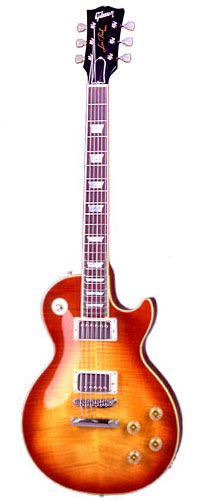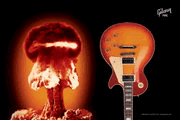|
Gibson Les PaulFrom Wikipedia, the free encyclopedia Period: 1952 — 1960, 1968 — present Construction Neck: Mahogany Fretboard: Ebony, Rosewood Hardware Colors available It was introduced in 1952, and has been out of production only once, in the years between 1960 and 1968, when another design, also initially called the 'Les Paul,' but soon renamed the 'SG', took over temporarily as Gibson's flagship instrument of the kind. The Les Paul model represented a design collaboration between the fairly stolid Gibson company, under president Ted McCarty, and the pop star, electronics inventor and accomplished jazz guitarist Les Paul. After the debut of the Fender Telecaster series guitars, in 1950, solid-body electric instruments became a craze, and Les Paul was brought in by the company as an innovative and respected figure who had experimented with them on his own. An early hand-built prototype of his, called 'the Log,' was once widely considered the first solid-body Spanish (as opposed to 'Hawaiian,' or lap-steel) guitar ever built, although numerous other prototypes and limited-production models have since resurfaced. Paul had earlier, in 1945 or 46, approached Gibson with this prototype, and had been "shown the door." The new guitar was to be an expensive, well-made instrument in Gibson's tradition, in response to the plain, bolted-together construction of the Fender guitars. Recollections differ on who contributed what to the design, but Gibson had offered electric hollowbody guitars since the 1930s, and provided at minimum a basic set of design cues, including a more traditionally curved body shape than that of Fender's futuristic-utilitarian models, and a glued-in ("set") neck, rather than Fender's bolt-on design. According to Gibson's president Ted McCartney, Gibson showed Paul a nearly finished instrument in 1951, and Gibson was mainly interested in having Paul's name on the headstock, as it would increase sales. Discussions with Paul were on the fitting of a maple cap over the mahogany body for increased density and sustain (which Paul wanted the other way around, but according to Gibson the guitar would become too heavy) and the tailpiece. For flash's sake, and to drive the point home that the Les Paul model was a quality instrument Les Paul also specified that it be offered with a gold finish. Later models included "flame" and "tiger" maple finishes for the top, as on fine furniture, and again in contrast to Fender's range of car-like custom body paint jobs. The 1952 Les Paul featured two single-coil pickups, and a one-piece, 'trapeze'-style bridge and tailpiece, in which the strings were fitted under, instead of over, a steel stop-bar. It was a very heavy instrument (around 9 pounds), and an expensive one, yet it had phenomenal sustain and a smooth, rich tone. Both the tonal characteristics and weight owe largely to the Les Paul's construction of mahogany and maple, both quite heavy woods. The guitar had some bugs to be worked out, and subsequent models saw the trapeze tailpiece changed to a standard Gibson design. (Les Pauls have always had their strings mounted on the top of the guitar body, as on Gibson's hollowbody instruments, rather than through the body as in Fender's designs). More advanced pickups were developed and fitted, and the Les Paul soon became a family of guitars; the Standard, Custom, and Deluxe, each with different options and finishes, and a different trim level. For various reasons (declining sales due to the high price, and strong competition from the more popular "surf" guitars offered by Fender), the Les Paul model received a complete make- over in 1960. The model became thinner, and received two pointy cut-aways. In 1963, the name of this model changed from "Les Paul Model" to "Gibson SG". According to Les Paul this was because he never liked the new instrument, but the real reason is that he was cutting down his financial affairs in preparation for his divorce with Mary Ford. In the 1960s, artists such as Mike Bloomfield, Keith Richards,Jimmy Page and Eric Clapton realized the potential of the late '50s Les Paul guitars (particularly the 1959 model) and gave them wide exposure. These guitars featured the thicker, more sustaining tone of Gibson's "humbucking" pickups (the original units are also known as "PAF" — "Patent Applied For" — pickups). The PAFs were designed by Seth Lover while working for Gibson in 1955, and became a standard design for Gibson and many other companies. After Clapton and Bloomfield, other guitarists quickly jumped on the bandwagon, and over the years 1950s Les Pauls have become some of the most desirable and expensive electric guitars in the world. A 1959 Les Paul in good condition can now easily bring prices between $100,000 and $250,000. The model was reintroduced in 1968, with minor changes. The Les Paul is available today in a baffling array of past and present variants, and has been played by a good portion of the most important guitarists of the past half-century. Les Paul himself still plays his personal Les Paul (which, as an inveterate tinkerer, he has heavily modified over the years) onstage, weekly, in New York City (As of Sept. 2005 Mondays at the Iridium jazz club at 51st St, & Broadway). Paul prefers the 'Recording' variation, with different electronics and a one-piece mahogany body.
Gibson offers exact copies of all 1950's models, and only experts can spot the difference. However, players feel the copies are close, but not as good as original 1950's models. According to them, the "tone wood" used in the 1950's just isn't available anymore. An electric bass version also exists, although it is less esteemed by players.Notable players of the Gibson Les Paul include, Steve Vai, Slash, Adam Jones,Richie Sambora,mike bloomfiEld/electric flag Alex Lifeson, ,Jimmy Page, Gary Moore, Pete Townshend, Duane Allman, Eric Clapton (in his John Mayall & the Bluesbreakers and Cream eras and occasionally present period), James Iha, Mick Ronson, Ace Frehley,MARTIN BARRE OF JETHRO TULL Scott Gorham, Tom Scholz, Joe Perry, Robert Fripp, Peter Green, Mick Taylor, Zakk Wylde, Peter Frampton, Buzz Osborne, James Dean Bradfield, Tak Matsumoto, Mark Knopfler, Noel Gallagher, Steve Jones, The Edge, Mick Jones, Billy Gibbons, Steve Hackett, Marc Bolan, Frank Zappa, Joel Hanson, Phil Keaggy, Adam Sandler, Matt Skiba, Gorillaz, ,Tom Morello and the late Randy Rhoads. Many other electric guitar players have played it at one time or another. This article is licensed under the GNU Free Documentation License. It uses material from the Wikipedia article "Gibson Les Paul".
|





